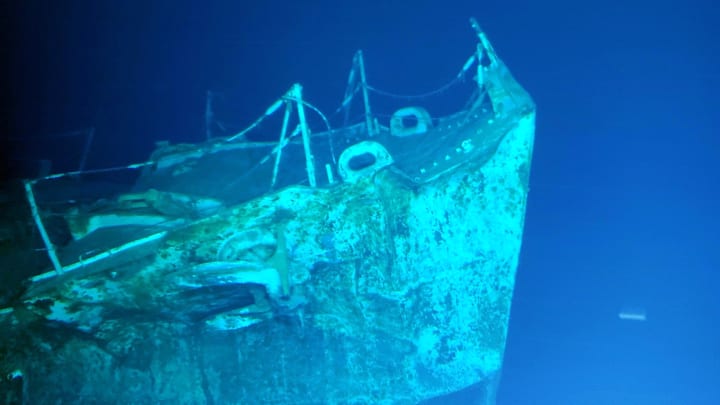In October 1944, during the Battle off Samar—one of four major actions during the Battle of Leyte Gulf in World War II’s Pacific theatre—the USS Samuel B. Roberts found itself in dire straits.
The destroyer escort had only a fraction of the guns and torpedoes carried by the naval warships it accompanied. It stood no chance against the Imperial Japanese naval force, which was desperate to fight off a U.S. invasion of the Philippines at Leyte Gulf. After firing every round of ammunition, smoke shell, and illumination round on board to provide a protective smoke screen for the destroyers, the Sammy B was sunk by a Japanese battleship and disappeared into the depths of the Philippine Trench, dragging around 90 of its 224 crew members with it.
Nearly 80 years later, American adventurer Victor Vescovo piloted his deep-sea submersible Limiting Factor in the Philippine Trench and managed to locate the wreck of the Sammy B. The ship, which had broken in two during its long descent to the seafloor, confirmed details about the Battle off Samar that had previously been known only from eyewitness accounts, such as punctures in the stern showing exactly where Japanese shells had fatally struck.
The vessel’s final stand “was just an extraordinary act of heroism,” Vescovo told the BBC following the 2022 discovery. “Those men—on both sides—were fighting to the death.”
Under Pressure
Equally impressive is the depth at which the Sammy B settled. It lies at a staggering 22,621 feet—or 4.28 miles—below sea level, where the temperature remains around 32°F and the pressure rises to 5 tons per square inch.

Located in one of the deepest sections of one of the deepest trenches in the world, it should come as little surprise that the Sammy B currently holds the title of the deepest shipwreck ever discovered. It broke the record held by the USS Johnston, a U.S. naval destroyer that sank during the same battle as the Sammy B and in the same deep-sea trench. An expedition team led by Microsoft co-founder and explorer Paul Allen discovered the wreck in 2019, and another expedition led by Vescovo confirmed its identity in 2021.
While the Sammy B remains No. 1 for the time being, it’s possible that other shipwrecks from the Second World War reached even greater depths after going under, including the still-unlocated escort carrier USS Gambier Bay and destroyer USS Hoel.
5 of the Deepest Shipwrecks Ever Found
Warships aren’t the only thing that have come to rest at incredible ocean depths. A list of the five deepest wrecks ever found also includes passenger and merchant ships, and all were sunk during World War II.
Ship | Depth | Location | Date of Sinking | Cause | Date of Discovery |
|---|---|---|---|---|---|
USS Samuel B. Roberts | 22,621 feet | Philippine Trench | October 25, 1944 | Shelled by Japanese battleship | June 22, 2022 |
USS Johnston | 21,180 feet | Philippine Trench | October 25, 1944, during the Battle off Samar | Drew fire from Japanese ships | October 30, 2019; identified in March 2021 |
SS Rio Grande | 18,904 feet | Southern Atlantic Ocean near Brazil | January 4, 1944 | Gunfire from USS Omaha and USS Jouett | November 28, 1996 |
USS Indianapolis | 18,044 feet | Philippine Sea | July 30, 1945 | Torpedoed by Japanese submarine | August 19, 2017 |
SS City of Cairo | Roughly 17,000 feet | Southern Atlantic Ocean near St. Helena | November 6, 1942 | Torpedoed by German submarine | 2011 |
Read More Stories About Shipwrecks:
